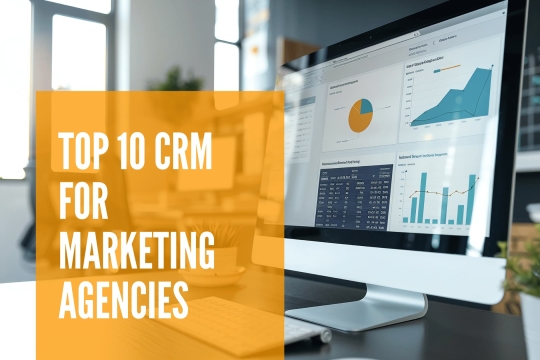Best Practices for Campaign Automation to Generate More Leads

For many organizations, automation is the difference between sending out generic campaigns and delivering experiences tailored to individual customer needs. By integrating tools that manage data, trigger workflows, and personalize content, businesses can align their marketing and sales teams more effectively while creating consistent messaging across multiple channels.
This article examines the best practices for campaign automation that enable organizations to enhance lead generation, foster stronger customer relationships, and refine their marketing efforts. From laying a strong foundation with data to implementing advanced segmentation, we’ll walk through practical strategies you can apply to achieve better results with your campaigns.
Why Campaign Automation Matters for Lead Generation
Marketing has shifted from broad, one-size-fits-all messaging to targeted campaigns that adapt to customer needs. Campaign automation sits at the center of this shift, helping businesses streamline processes while improving how they attract and nurture leads.
Key Benefits of Campaign Automation for Lead Generation
- Reduces repetitive tasks
Automation handles routine work such as scheduling emails, following up with leads, or updating customer records. This frees up marketing and sales teams to focus on higher-value activities. - Strengthens alignment between sales and marketing
With shared access to customer data and consistent workflows, both teams can track progress through the sales cycle and hand off leads at the right time. - Improves targeting through customer data
By collecting and analyzing behavioral data, automation tools enable businesses to send targeted messages to the most relevant customer segments. - Supports lead nurturing at scale
Automated workflows can deliver timely follow-ups, educational content creation via blog posts or newsletters, and reminders that move prospects from awareness to decision-making. - Ensures consistent messaging across multiple channels
Whether through email marketing, SMS, or paid ads, automation ensures that customers receive a consistent and unified experience throughout their customer journey.
- New to CRMs and don’t know where to start?
- Stuck with a broken setup that someone else botched?
- Tried the DIY route but know it’s not working the way it should?
At PointsPeak, we help businesses:
- Choose the right CRM for their needs
- Clean up and rebuild messy, underperforming setups
- Fix automation issues that cost you leads and sales
- Build scalable, conversion-focused systems that grow with you
Why It Matters for Businesses
- Campaign automation enables more effective marketing efforts by combining efficiency with personalization.
- Instead of relying on generic marketing messages, businesses can engage customers with relevant, timely communications.
- Ultimately, automation drives higher lead quality and better conversion rates by aligning campaigns with real customer behavior.
Setting the Foundation for Successful Campaign Automation
Before launching automated workflows, it’s crucial to establish a solid foundation. Without clear goals, reliable data, and collaboration between teams, automation can quickly become inefficient or even counterproductive. By taking the time to establish these essentials, businesses can ensure their automation strategies drive meaningful results.

1. Align Sales and Marketing Teams
Automation is most effective when both marketing and sales teams share the same objectives. Agreeing on definitions for qualified leads, campaign goals, and customer handoff points ensures that automation supports the full sales cycle. Alignment prevents duplicate efforts, improves collaboration, and creates a smoother experience for prospects.
2. Define Key Performance Indicators (KPIs)
Clear measurement is essential for optimizing campaigns. Before setting up automated workflows, identify which KPIs best represent success, such as lead generation volume, conversion rates, or customer engagement. Tracking the right indicators allows teams to adjust campaigns quickly and continuously improve performance.
3. Maintain Clean and Accurate Customer Data
Automation relies on the quality of customer data. Incomplete or outdated information leads to irrelevant messages and missed opportunities. Regular data hygiene, such as removing duplicates, correcting errors, and updating contact details, ensures campaigns deliver relevant content to the right audience.
4. Integrate CRM Systems with Automation Software
A strong connection between customer relationship management systems and automation tools provides a unified view of the customer journey. This integration allows marketing teams to use behavioral data, purchase history, and engagement insights to create more personalized campaigns. It also helps sales reps see exactly how prospects have interacted with previous marketing efforts.
5. Understand Customer Behavior and Key Data Points
Effective marketing automation efforts start with understanding how customers interact with your brand. Analyzing user behavior, from email opens to website visits, reveals patterns that shape more relevant campaigns. Mapping these data points ensures automation aligns with customer needs at every stage of the journey.
Best Practices for Campaign Automation
Once the foundation is in place, the next step is applying proven strategies that make automation truly effective. These marketing automation best practices help businesses increase lead quality, strengthen customer relationships, and improve campaign performance across multiple channels.

1. Use Advanced Segmentation to Deliver Personalized Campaigns
Not all customers are the same, which is why segmentation is essential. By dividing audiences into smaller groups based on behavior, demographics, or purchase history, businesses can deliver more relevant messages. Advanced segmentation enables targeted campaigns that address the unique needs of specific audience segments rather than relying on generic marketing messages.
Personalized campaigns also improve engagement. For example, a customer who has recently downloaded a white paper may respond better to follow-up educational content, while someone who has requested a demo may prefer product-specific resources. Segmentation ensures that content aligns with customer intent, resulting in higher conversion rates and more effective lead nurturing.
2. Map Campaigns to the Entire Customer Lifecycle
Automation is most effective when it supports every stage of the customer lifecycle, from awareness to retention. Mapping campaigns across this journey ensures that new leads, prospects, and existing customers receive timely and relevant communications.
For instance, new leads may benefit from an onboarding series that introduces them to your brand, while loyal customers may receive upsell campaigns highlighting complementary products or services. By using automated workflows to cover the entire customer journey, businesses deliver consistent messaging and maximize customer lifetime value.
3. Leverage Multiple Channels for Consistent Messaging
Relying on a single channel limits the impact of marketing automation. Instead, campaigns should integrate email marketing, SMS marketing, paid ads, and social media management. Each channel plays a role in reinforcing messaging, reaching different customer segments, and increasing engagement opportunities.
Consistency is key. Customers who see aligned messages across multiple platforms are more likely to trust the brand and take action. At the same time, automation tools allow businesses to tailor content for each channel, ensuring it feels relevant rather than repetitive. This cross-channel approach builds stronger connections and helps optimize campaigns for maximum reach.
4. Focus on Content Creation and Personalized Messages
Strong automation requires strong content. Without relevant and engaging material, even the most advanced workflows will fall flat. Personalized content, such as tailored subject lines, dynamic fields, and messaging based on customer lifecycle stages, creates a sense of connection that drives higher engagement.
For example, a subject line that references a customer’s recent activity (“Still interested in your free trial?”) is more likely to capture attention than a generic message. Similarly, delivering content that reflects a lead's position in the sales cycle ensures that communications feel timely and valuable.
Personalized messages not only increase open and click-through rates but also build trust, making customers more receptive to future campaigns.
5. Automate Repetitive Tasks Without Losing Human Touch
One of the biggest advantages of automation is its ability to handle repetitive tasks, such as sending reminders, following up with leads, or scheduling content. This efficiency allows teams to scale efforts without overwhelming resources.
However, it’s important to avoid making interactions feel robotic. Balance automation with opportunities for genuine human engagement, such as personalized outreach from a sales rep or customer success manager. This combination of efficiency and authenticity ensures campaigns remain effective while preserving customer relationships.
6. Optimize Campaigns with Real-Time Data
Marketing automation makes it possible to track and react to campaign performance in real time. Businesses can quickly see which messages are resonating, which channels are driving engagement, and where drop-offs occur in the funnel.
Using this data, marketing teams can adjust subject lines, tweak workflows, or shift targeting mid-campaign to improve outcomes. Real-time optimization keeps campaigns relevant and maximizes return on investment. It also prevents wasted spend on underperforming strategies.
7. Implement Lead Scoring for Better Sales Handoffs
Not all leads have the same level of interest or readiness to make a purchase. Lead scoring helps marketing teams rank prospects based on engagement, behavior, and demographics, ensuring sales reps focus on the most qualified opportunities.
For example, a prospect who opens multiple emails, downloads resources, and visits pricing pages would receive a higher score than someone who only signed up for a newsletter. By defining clear scoring criteria, businesses can improve collaboration between their sales and marketing teams, ultimately increasing conversion rates.
Lead scoring also shortens the sales cycle by ensuring that sales teams engage customers at the right time, when interest is high and intent is clear.
8. Continuously Test and Optimize Campaign Performance
Automation is not a “set it and forget it” process. To achieve consistent results, businesses must regularly test their campaigns and refine them based on performance data. A/B testing subject lines, messaging, workflows, or even sending times can reveal which elements drive better engagement.
Tracking key performance indicators, such as open rates, click-through rates, and lead generation volume, provides insights into what’s working and what needs improvement. By adopting a cycle of continuous optimization, marketing professionals can ensure that their campaigns evolve in line with changing customer behavior and market conditions.
Choosing the Right Marketing Automation Platform
Selecting the right marketing automation platform is one of the most important decisions for any business looking to scale its campaigns. With so many options available, it’s essential to choose the right marketing automation software that not only meets current needs but can also grow alongside your business.
What to Look for in a Platform
- CRM integration
Seamless connection with customer relationship management systems allows teams to unify data and track the entire customer journey. This integration ensures that marketing automation campaigns are informed by accurate customer data and behavioral insights. - Scalability
As marketing efforts expand, the platform should be able to handle larger customer segments, additional workflows, and more complex automation strategies without performance issues. - Ease of use
A platform should simplify campaign creation and management. Intuitive interfaces and user-friendly automation tools reduce the learning curve for marketing teams and allow faster execution. - Multi-channel support
Modern marketing campaigns require consistency across multiple channels, including email marketing, SMS, social media management, and paid ads. A good platform supports all these channels and enables consistent messaging throughout the sales cycle.
Evaluating Options
When comparing marketing automation tools, consider how well they align with your broader marketing strategy. For example, a small business may prioritize ease of use and cost-effectiveness, while a larger organization might value advanced segmentation, real-time data analysis, and strong reporting features.
Ultimately, the right platform is the one that enables your business to automate tasks across the entire customer lifecycle, engage customers with relevant messages, and optimize campaigns effectively.
Common Mistakes to Avoid in Campaign Automation
Even with powerful software and well-designed strategies, campaign automation can fall short if common mistakes aren’t addressed. Avoiding these pitfalls ensures your automation efforts stay effective and customer-focused.
Over-automation
Automating too many touchpoints can make customer interactions feel robotic and impersonal. While automation saves time, it should not replace authentic human engagement. Customers still expect meaningful communication when it matters most.
Relying on Generic Marketing Messages
Sending the same content to every contact reduces relevance and damages engagement. Without segmentation or personalization, campaigns risk being ignored or marked as spam. Tailoring messages to customer behavior and audience segments is critical.
Ignoring the Customer Experience
Focusing too heavily on internal efficiency can harm the customer journey. Automation must enhance, not hinder, the customer experience. Overloading customers with frequent emails or irrelevant offers often leads to unsubscribes and a loss of trust.
Poor Collaboration Between Teams
If sales and marketing teams don’t collaborate, automation can create silos instead of alignment. Clear communication and shared access to campaign performance data ensure both teams benefit from automation.
Failing to Track Key Performance Indicators
Without KPIs, there’s no clear way to measure success. Skipping performance tracking prevents teams from optimizing campaigns and understanding what drives lead generation. Monitoring key metrics, such as open rates, click-through rates, and conversion rates, is essential.
If you’re thinking, “There’s probably a better way to do this…” — you’re probably right.
Future Trends in Marketing Automation
The world of marketing automation continues to evolve as technology advances and customer expectations shift. Businesses that stay ahead of these trends will be better positioned to deliver relevant messages and improve campaign performance.
1. AI-Driven Personalization
Artificial intelligence is making it possible to analyze customer behavior at a deeper level. Predictive analytics and machine learning allow businesses to anticipate customer needs and deliver highly targeted content at the right time.
2. Real-Time Campaign Adjustments
Instead of relying solely on pre-built workflows, future automation tools will emphasize the use of real-time data. Marketers will be able to adjust campaigns instantly, responding to user behavior as it happens.
3. Deeper CRM and Sales Cycle Integration
Automation platforms are increasingly integrating with CRM systems, providing sales and marketing teams with a comprehensive view of the customer journey. This allows smoother lead handoffs, better lead nurturing, and improved sales outcomes.
4. Expansion Across Multiple Channels
As customers engage with brands across more platforms, automation strategies will extend further into social media, SMS, and even emerging channels, such as messaging apps. Multi-channel consistency will become a standard expectation.
5. Smarter Use of Behavioral Data
Future tools will leverage more granular behavioral data, from browsing history to engagement across target audience segments. This deeper understanding of customer actions will help businesses create campaigns that feel personal and timely.
Conclusion
Campaign automation has become one of the most effective ways for businesses to generate leads, nurture prospects, and engage existing customers. By following best practices, including segmentation, lifecycle mapping, cross-channel messaging, and continuous optimization, organizations can build campaigns that feel personal while running at scale.
The key to success lies in striking the right balance: automating repetitive tasks without losing the human touch, utilizing data to inform strategy while keeping the customer experience at the center, and aligning sales and marketing teams to work toward shared objectives.
With the right automation strategies and tools in place, businesses can increase conversion rates, improve lead quality, and deliver consistent messaging across the entire customer lifecycle. Campaign automation is not just about efficiency. It’s about creating meaningful connections that drive long-term growth.
Looking to implement these strategies in your own business? At PointsPeak Marketing, we help organizations design, optimize, and manage marketing automation systems that deliver real results. Contact us today to learn how we can support your growth through smarter automation.
FAQs
The biggest advantage is the combination of efficiency and personalization. Campaign automation streamlines repetitive tasks, ensuring customers receive timely and relevant messages. This leads to stronger engagement, improved lead nurturing, and higher conversion rates.
Begin by evaluating your current marketing strategy and future growth objectives. Look for platforms that integrate with your CRM, support multiple channels, and provide strong reporting features. Ease of use and scalability are also critical when evaluating marketing automation tools.
No. Automation is designed to support marketing professionals, not replace them. While it handles tasks like scheduling, segmentation, and reporting, humans are still essential for creating strategy, developing personalized content, and building authentic relationships.
Campaigns should be reviewed regularly, ideally every quarter. Monitoring campaign performance and customer behavior ensures that workflows stay relevant and aligned with your audience’s needs. Updates may include refreshing subject lines, adjusting segmentation, or creating new content.
Common KPIs include open rates, click-through rates, conversion rates, lead quality, and customer engagement. These metrics provide insight into how well your campaigns are performing and where adjustments are needed.
Automation enables shared visibility into customer data and campaign activity. By defining lead scoring criteria and aligning on the customer journey, sales and marketing teams can coordinate more effectively, ensuring that leads are nurtured properly and handed off at the right time.


